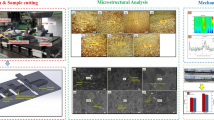Abstract
Carbon fiber composites have excellent properties and can be used in automobile, aircraft, rail transit and other fields of lightweight, but Its price is very expensive. For reducing the cost and improving the comprehensive properties of materials which contain carbon fiber composites and used in the fields mentioned above, carbon fiber (CF) and glass fiber (GF) were mixed to replace pure carbon fiber composites. Three different methods were used to treat the surface of carbon fiber (ultrasonic surface cleaning, liquid phase oxidation of concentrated nitric acid and ultrasonic combined concentrated nitric acid oxidation) and different contents of silane coupling agent KH-550 (0 %, 0.2 %, 0.5 %, 1.0 %) were used to treat the glass fiber, and the laminated plate was prepared by Vacuum Assisted Resin Transfer Molding (VARTM). The CF/GF hybrid composite laminates were prepared by combining the best surface treatment method and the best stacking scheme of carbon fiber and glass fiber. The tests of mechanical properties and the observation of SEM fracture morphology show that, the surface treatment of CF by ultrasonic combined concentrated nitric acid oxidation is the best; mechanical properties of GF reinforced composite were the best when surface treatment was carried out with 0.5 % silane coupling agent; Compared with the untreated samples, the mechanical properties of CF/GF hybrid composite laminates after surface treatment were improved, the thickness and weight are reduced. Thus, the weight reduction and better performances were achieved.
Similar content being viewed by others
References
C. Han, J. Phys.: Conf. Ser., 1676, 012085 (2020).
I. Papa, L. Boccarusso, A. Langella, and V. Lopresto, Compos. Struct., 232, 111571 (2020).
P. Hung, K. Lau, B. Fox, N. Hameed, J. Lee, and D. Hui, Compos. Part B Eng., 133, 240 (2018).
P. Reis, J. Ferreira, F. Antunes, and J. Costa, Compos. Part A Appl. Sci. Manuf., 38, 1612 (2007).
A. Murdani and U. Amrullah, IOP Conf. Ser.: Mater. Sci. Eng., 1173, 012067 (2021).
S. Sunil, N. Londe, A. Saviraj, and V. Kannanth, Mater. Today: Proc., 4, 10751 (2017).
R. Murugan, R. Ramesh, and K. Padmanabhan, Procedia Eng., 97, 459 (2014).
M. Cavatorta, J. Mater. Sci., 42, 8636 (2007).
T. Czigany, Compos. Sci. Technol., 66, 3210 (2005).
G. Marom, S. Fischer, F. Tuler, and H. Wagner, J. Mater. Sci., 13, 1419 (1978).
C. Zhang, J. Huang, X. Li, and C. Zhang, Fiber. Polym., 21, 2873 (2020).
B. Fernández, A. Arbelaiz, A. Valea, F. Mujika, and I. Mondragon, Polym. Compos., 25, 319 (2004).
X. Xu, X. Wang, Q. Cai, X. Wang, R. Wei, and S. Du, J. Mater. Sci. Technol., 32, 226 (2016).
X. Qian, X. Wang, Q. Yang, Y. Chen, and Q. Yan, Appl. Surf. Sci., 259, 238 (2012).
W. Li, S. Yao, K. Ma, and P. Chen, Polym. Compos., 34, 368 (2013).
H. Guo, Y. Huang, L. Meng, L. Liu, D. Fan, and D. Liu, Mate. Lett., 63, 1531 (2009).
M. B. Borooj, A. M. Shoushtari, E. N. Sabet, and A. Haji, J. Adhes. Sci. Technol., 30, 2372 (2016).
M. B. Borooj, A. M. Shoushtari, A. Haji, and E. N. Sabet, Compos. Sci. Technol., 128, 215 (2016).
Y. M. Lee, J. You, M. Kim, T. A. Kim, S. S. Lee, J. Bang, and J. H. Park, Compos. Part B Eng., 165, 725 (2019).
B. G. Cho, S. H. Hwang, M. Park, J. K. Park, Y. B. Park, and H. G. Chae, Compos. Part B Eng., 160, 436 (2019).
T. Zeng, Fiber Glass, 5, 13 (2006).
V. Tomao, A. Siouffi, and R. Denoyel, J. Chromatogr. A, 829, 367 (1998).
W. Sun, H. Zeng, L. Niu, and Y. Gu, Compos. Sci. Eng., 1, 33 (2000).
W. Luo, X. Wang, R. Huang, and P. Fang, Wuhan Univ. J. Nat. Sci., 19, 34 (2014).
W. Yan, K. Han, H. Zhou, and M. Yu, J. Appl. Polym. Sci., 99, 775 (2006).
Y. Xue and X. Cheng, J. Mater. Sci. Lett., 20, 1729 (2001).
V. Cech, R. Prikryl, and R. Balkova, Compos. Part A Appl. Sci. Manuf., 33, 1367 (2002).
Acknowledgements
This work was financially supported by National Natural Science Foundation of China (No.51705295, 51778351), Key project of the Shandong Provincial Natural Science Foundation, China (ZR2020KE013), Shandong University of Science and Technology Research Fund of China (No.2018TDJH101) and University Qing Chuang science and technology plan of Shandong (No. 2019KJB015).
Author information
Authors and Affiliations
Corresponding author
Ethics declarations
No conflict of interest exits in the submission of this manuscript, and manuscript is approved by all authors for publication.
Rights and permissions
About this article
Cite this article
Lou, S., Ren, G., Zhang, H. et al. Effect of Surface Treatment on Properties of Carbon Fiber and Glass Fiber Hybrid Reinforced Composites. Fibers Polym 23, 3225–3231 (2022). https://doi.org/10.1007/s12221-022-0374-1
Received:
Revised:
Accepted:
Published:
Issue Date:
DOI: https://doi.org/10.1007/s12221-022-0374-1




